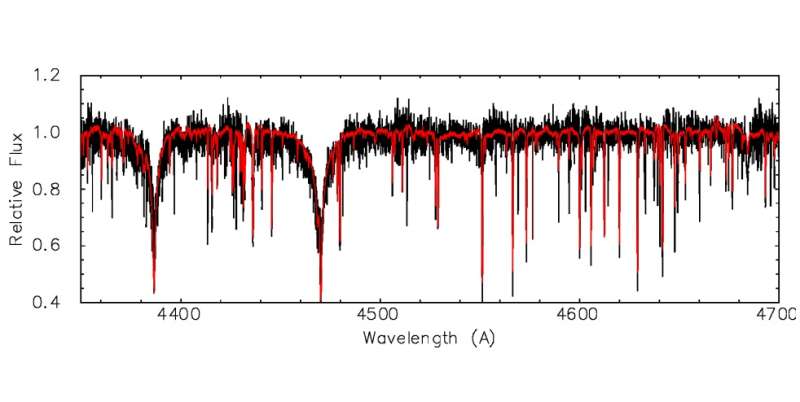June 20, 2017 report
Rare extreme helium star identified by astronomers

(Phys.org)—Astronomers have identified another rare example of an extreme helium star. The star, designated GALEX J184559.8−413827 (or J1845−4138 for short), was initially classified as a faint helium-rich "hot subdwarf," but new spectroscopic observations reveal that this star is more hydrogen-deficient than previously thought. The finding is available in a paper published June 11 on arXiv.org.
Extreme helium stars (EHes) are supergiants much larger and hotter than the sun, but less massive. They are almost devoid of hydrogen, which is unusual, as hydrogen is the most abundant chemical element in the universe. EHes are characterized by relatively sharp and strong lines of neutral helium, which indicates low surface gravities and atmospheres dominated by helium. Besides helium, these stars also have significant amounts of carbon, nitrogen and oxygen. EHe was first detected in 1942.
The discovery of GALEX J184559.8−413827 was announced in 2011 and was based on the data provided by NASA's Galaxy Evolution Explorer (GALEX) satellite. Given that the star was classified as a helium-rich "hot subdwarf," it was put on a target list for observations of chemically peculiar objects with the high-resolution spectrograph (HRS) on the Southern Africa Large Telescope (SALT), located near Sutherland, South Africa.
Now, Simon Jeffery of the Armagh Observatory and Planetarium in College Hill, Northern Ireland, presents the results of new observations of GALEX J184559.8−413827 conducted with HRS in March 2017. According to Jeffery, the high-resolution spectrum obtained with the use of HRS indicates that the observed object is a nitrogen-rich EHe star.
"A spectroscopic survey of stars classified as helium-rich subdwarfs, especially He-sdB or sdOD using 8m-class telescopes has been undertaken. This paper reports an observation of one such star obtained with the high-resolution spectrograph on the Southern Africa Large Telescope. (...) SALT HRS observations of a faint-blue star previously classified He-sdB (Vennes et al. 2011) demonstrate it to be a nitrogen-rich EHe star similar to the pulsating EHe star V652 Her," the paper reads.
Jeffrey acknowledged that GALEX J184559.8−413827 is four magnitudes fainter than V652 Her. Spectroscopic similarities with V652 Her suggest the new EHe star has similar evolutionary status, which suggests that it formed as a result of a double helium white dwarf merger. Moreover, it also means that GALEX J184559.8−413827 could evolve to become a helium and nitrogen-rich hot subdwarf within about 100,000 years.
Notably, GALEX J184559.8−413827 is the first EHe star to be discovered for nearly 40 years. This highlights the extreme rarity of such stars.
The question that remains unanswered is whether GALEX J184559.8−413827 also pulsates like V652 Her. So far, no evidence of any periodic variability of the new EHe star was found.
Jeffery concluded that his study is promising when it comes to future detections of new EHe stars.
"This discovery suggests that there are more EHe stars waiting to be found, at least with relatively low luminosities. A higher signal-to-noise spectrum will allow abundances and other parameters to be refined further," he wrote in the paper.
More information: GALEX J184559.8-413827: a new extreme helium star identified using SALT, arXiv:1706.03377 [astro-ph.SR] arxiv.org/abs/1706.03377
Abstract
A high-resolution spectrum of the helium-rich 'hot subdwarf' GALEX J184559.8-413827 (J1845-4138) obtained with SALT HRS demonstrates it to be the first extreme helium (EHe) star to be discovered in nearly 40 years. A quantitative analysis demonstrates it to have an atmosphere described by Teff = 26 170 +/- 750 K, log g /(cm s^-2) = 4.22 +/- 0.10, and a surface chemistry characterised by CNO-processed helium, a 1% contamination of hydrogen (by number), and a metallicity 0.4 dex subsolar. Its distance and position are consistent with membership of the Galactic bulge. Its sharp absorption lines place strong constraints on both the rotation and microturbulent velocities. Spectroscopically, J1845-4138 closely resembles the pulsating EHe star V652 Her, generally considered to be the product of a double helium white dwarf merger evolving to become a helium-rich sdO star.
© 2017 Phys.org



















